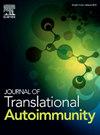Homeostatic signals, including IL-7 and self-MHC recognition, induce the development of peripheral helper T cells, which are enriched in the joints of rheumatoid arthritis
IF 3.6
Q2 IMMUNOLOGY
引用次数: 0
Abstract
Objective
Dysregulated T cell homeostasis has long been implicated in the pathogenesis of rheumatoid arthritis (RA), in the joint of which peripheral helper T (Tph) cells accumulate and form ectopic lymphoid organs. We examined whether homeostatic signals are involved in the development of Tph cells.
Methods
Human peripheral blood mononuclear cells were cultured with IL-7, the critical cytokine for T cell homeostasis. Development of Tph-like cells was assessed by flow cytometry, gene expression, and functional analysis. Chemotaxis of the Tph-like cells to RA synovial fluid (RASF) and the effect of RASF on the development of Tph-like cells was examined.
Results
PD-1highCXCR5- Tph-like cells developed from human peripheral blood CD4 T cells after proliferation in response to IL-7. Signals from self-MHC recognition and CD28 co-stimulation were also involved. The IL-7-induced Tph-like (IL-7-Tph) cells produced CXCL13 and IL-21 and helped B cells produce IgG. Comprehensive gene expression analysis further supported the similarity with Tph cells in RA joint. IL-7-Tph cells exhibited chemotaxis toward synovial fluid from RA patients (RASF), and RASF promoted the development of IL-7-Tph cells, which were also induced from CD4 T cells residing in non-inflamed joints.
Conclusions
Our results demonstrate an antigen-nonspecific developmental pathway of Tph cells triggered by homeostatic signals and promoted by the local environment of RA, which accounts for the accumulation of Tph cells in inflamed joints.
IL-7和自身MHC识别等体内平衡信号诱导外周辅助T细胞的发育,这些细胞在类风湿性关节炎的关节中富集
目的长期以来,T细胞稳态失调一直被认为与类风湿性关节炎(RA)的发病机制有关,在类风湿性关节炎的关节中,外周辅助性T细胞(Tph)聚集并形成异位淋巴器官。我们研究了平衡信号是否参与了 Tph 细胞的发育。方法用 IL-7 培养人外周血单核细胞,IL-7 是 T 细胞平衡的关键细胞因子。通过流式细胞术、基因表达和功能分析评估了Tph样细胞的发育情况。研究了Tph样细胞对RA滑液(RASF)的趋化作用以及RASF对Tph样细胞发育的影响。来自自身-MHC 识别和 CD28 协同刺激的信号也参与其中。IL-7诱导的Tph样细胞(IL-7-Tph)能产生CXCL13和IL-21,并帮助B细胞产生IgG。全面的基因表达分析进一步证实了与 RA 关节中 Tph 细胞的相似性。IL-7-Tph细胞对来自RA患者的滑液(RASF)表现出趋化性,RASF促进了IL-7-Tph细胞的发育,而这些细胞也是从非炎症关节中的CD4 T细胞中诱导出来的。
本文章由计算机程序翻译,如有差异,请以英文原文为准。
求助全文
约1分钟内获得全文
求助全文
来源期刊

Journal of Translational Autoimmunity
Medicine-Immunology and Allergy
CiteScore
7.80
自引率
2.60%
发文量
33
审稿时长
55 days
 求助内容:
求助内容: 应助结果提醒方式:
应助结果提醒方式:


